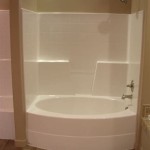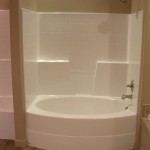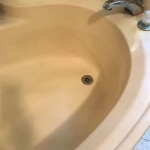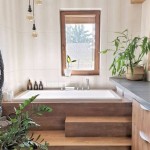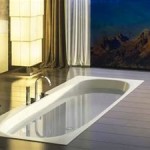Bathtub Trim Kit: Brushed Nickel Elegance and Functionality
A bathtub trim kit serves as a comprehensive solution for replacing or upgrading the visible hardware components of a bathtub. These kits typically include essential elements such as the bathtub spout, drain stopper, overflow plate, and handles for the faucet. Opting for a trim kit ensures a cohesive and aesthetically pleasing appearance, eliminating the need to individually source matching components. The brushed nickel finish has become a popular choice due to its understated elegance, durability, and resistance to water spots and fingerprints. This article explores the key benefits of choosing a brushed nickel bathtub trim kit, the factors to consider when selecting a kit, and the installation process, providing a comprehensive understanding of this bathroom upgrade option.
The Allure of Brushed Nickel
Brushed nickel offers a unique aesthetic that bridges the gap between contemporary and traditional design sensibilities. Unlike polished chrome, which boasts a reflective, mirror-like surface, brushed nickel presents a more muted and textured appearance. This is achieved through a finishing process that involves applying a fine abrasive to the nickel plating, resulting in subtle brush marks that diffuse light. This diffused reflection contributes to a softer, warmer ambiance in the bathroom, creating a more inviting and relaxing atmosphere.
Beyond its visual appeal, brushed nickel also offers practical advantages. The textured surface is less prone to showcasing water spots, fingerprints, and soap scum compared to its polished counterparts. This translates to reduced maintenance and a cleaner, more presentable appearance over time. Furthermore, the neutral tone of brushed nickel complements a wide range of bathroom color palettes and design styles. It pairs well with both light and dark hues, making it a versatile choice for various bathroom renovation projects. From minimalist modern designs to rustic farmhouse aesthetics, brushed nickel can seamlessly integrate into diverse design schemes.
The durability of brushed nickel is another compelling reason for its popularity. The nickel plating provides a protective layer against corrosion and rust, ensuring longevity and preventing the appearance of unsightly blemishes. This is particularly important in the humid environment of a bathroom, where moisture exposure is constant. Choosing a high-quality brushed nickel finish, preferably one that conforms to industry standards regarding corrosion resistance, will further enhance the lifespan of the trim kit and maintain its aesthetic appeal for years to come.
Key Considerations When Selecting a Bathtub Trim Kit
Selecting the right bathtub trim kit requires careful consideration of several factors to ensure compatibility, functionality, and desired aesthetic outcome. One of the primary considerations is compatibility with the existing plumbing system. Different bathtubs may have varying drain sizes, faucet configurations, and overflow designs. Therefore, it is crucial to accurately measure and identify the specifications of the current plumbing fixtures before purchasing a trim kit. Consulting with a plumbing professional may be beneficial to avoid potential compatibility issues and ensure a smooth installation process.
The valve type is another important factor to consider. Bathtub faucets can have different valve types, such as compression, ball, cartridge, or ceramic disc valves. The trim kit must be compatible with the existing valve type to ensure proper functionality. Replacing the valve along with the trim kit may be an option, but this will typically require more extensive plumbing work and should be performed by a qualified professional. Understanding the valve type and ensuring compatibility with the chosen trim kit is essential for a successful installation.
The material and construction quality of the trim kit are also crucial for long-term performance and durability. Opting for a kit made from solid brass or other high-quality materials will ensure resistance to corrosion and wear. The finish should be applied evenly and consistently to prevent premature peeling or fading. Examining customer reviews and product specifications can provide valuable insights into the quality and reliability of different trim kits. Investing in a well-constructed trim kit will ultimately save time and money in the long run by minimizing the need for replacements or repairs.
Finally, aesthetic preferences play a significant role in the selection process. Brushed nickel trim kits are available in a variety of styles, ranging from minimalist and modern to ornate and traditional. Choosing a style that complements the overall bathroom design and reflects personal taste is essential. Consider the shape and design of the spout, handles, and overflow plate to ensure they align with the desired aesthetic. Examining images of different trim kits installed in bathrooms can provide inspiration and help visualize the potential impact on the overall design. Coordinating the brushed nickel finish with other bathroom fixtures, such as lighting and cabinet hardware, will create a cohesive and harmonious look.
Installation of a Bathtub Trim Kit: A Step-by-Step Guide
Installing a bathtub trim kit can be a manageable DIY project for individuals with basic plumbing skills and experience. However, it is crucial to prioritize safety and follow proper procedures to avoid damage to the plumbing system or personal injury. Before commencing the installation, turn off the water supply to the bathtub faucet to prevent leaks or flooding. Place a towel or cloth over the drain to prevent small parts from falling into the drainpipe.
The first step is to remove the existing trim components. This typically involves unscrewing or prying off the old spout, handles, and overflow plate. Use appropriate tools, such as a screwdriver, wrench, or putty knife, and be careful not to damage the surrounding surfaces. Once the old components are removed, thoroughly clean the area around the drain, faucet, and overflow opening. Remove any old caulk, sealant, or debris to ensure a clean and smooth surface for the new trim kit.
Next, install the new drain stopper. The installation method will vary depending on the type of drain stopper. Some drain stoppers are simply inserted into the drain opening, while others require screwing or tightening a nut underneath the bathtub. Follow the manufacturer's instructions carefully to ensure proper installation and a watertight seal. Applying plumbers putty or silicone sealant around the drain flange can further enhance the seal and prevent leaks.
After installing the drain stopper, proceed with the installation of the overflow plate. The overflow plate is typically attached to the bathtub with screws. Align the new overflow plate with the existing screw holes and tighten the screws securely. Ensure that the overflow opening is properly aligned with the overflow pipe to prevent water from leaking behind the bathtub. Applying plumbers putty or silicone sealant around the overflow plate can also help create a watertight seal.
The installation of the bathtub spout is the next crucial step. The method of attachment will depend on the type of spout and the existing plumbing configuration. Some spouts slide onto a copper pipe and are secured with a set screw, while others are threaded onto a threaded pipe nipple. Before installing the spout, apply Teflon tape to the threads of the pipe nipple to create a watertight seal. Tighten the spout securely with a wrench, but be careful not to overtighten, which could damage the pipe or the spout. Once the spout is installed, turn on the water supply and check for leaks. If any leaks are detected, tighten the connections further or reapply Teflon tape.
Finally, install the new faucet handles. The installation method will vary depending on the type of handle and the valve stem. Some handles slide onto the valve stem and are secured with a set screw, while others are threaded onto the valve stem. Align the handles properly and tighten the screws or nuts securely. Ensure that the handles operate smoothly and that the hot and cold water are flowing properly. Once the handles are installed, turn on the water supply and check for leaks around the handles. If any leaks are detected, tighten the connections further or replace the O-rings if necessary.
After completing the installation, thoroughly clean the bathtub and surrounding area. Remove any tools, debris, or packaging materials. Inspect the entire installation to ensure that all components are properly installed and that there are no leaks. Allow the sealant to cure for the recommended time before using the bathtub. Following these steps carefully will ensure a successful installation of the brushed nickel bathtub trim kit and enhance the functionality and aesthetic appeal of the bathroom.

Brushed Nickel Tub Shower Trim Kits For Delta Valley Mixet And More

Keeney 1 3 8 In Or 2 Brushed Nickel Triplever Bathtub Trim Kit The Shower Drain Accessories Department At Com

Brushed Nickel Tub Shower Trim Kits For Delta Valley Mixet And More

Moen Part T42311cbn Baystone Lever Handle Tub Shower Trim Kit For Use With Cycling Valves In Brushed Nickel Bathtub Valve Kits Home Depot Pro

Moen Eva 1 Handle Spray Posi Temp Shower Faucet Trim Kit In Brushed Nickel Valve Not Included T2132bn The Home Depot

Brushed Nickel Tub Shower Trim Kits For Delta Valley Mixet And More

Danco 1 Handle Valve Trim Kit In Brushed Nickel For Delta Tub Shower Faucets Not Included 10004 The Home Depot

Brushed Nickel Universal Trim R90 Tn1k 1 Handle Tub Shower Kit Pfister Faucets

Brushed Nickel Tub Shower Trim Kits For Delta Valley Mixet And More

Danco Brushed Nickel 1 Handle Bathtub And Shower Faucet In The Faucets Department At Com
Related Posts



